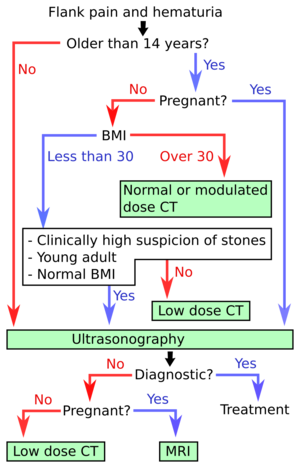Difference between revisions of "Template:Acute kidney stone disease - need and choice of modality"
Jump to navigation
Jump to search

m (Corrected) |
m (→Choice of modality: Despaced) |
||
| Line 5: | Line 5: | ||
[[File:Algorithm for kidney stone disease.png|thumb|Algorithm for kidney stone disease, developed in the US.<ref name=Brisbane2016>{{cite journal|last1=Brisbane|first1=Wayne|last2=Bailey|first2=Michael R.|last3=Sorensen|first3=Mathew D.|title=An overview of kidney stone imaging techniques|journal=Nature Reviews Urology|volume=13|issue=11|year=2016|pages=654–662|issn=1759-4812|doi=10.1038/nrurol.2016.154}}</ref>]] | [[File:Algorithm for kidney stone disease.png|thumb|Algorithm for kidney stone disease, developed in the US.<ref name=Brisbane2016>{{cite journal|last1=Brisbane|first1=Wayne|last2=Bailey|first2=Michael R.|last3=Sorensen|first3=Mathew D.|title=An overview of kidney stone imaging techniques|journal=Nature Reviews Urology|volume=13|issue=11|year=2016|pages=654–662|issn=1759-4812|doi=10.1038/nrurol.2016.154}}</ref>]] | ||
*'''[[Ultrasonography of kidney stone disease]]''' is the first-line imaging modality for patients <14 years of age and those who are pregnant. It is also the first-line investigation for thin (BMI <30) patients and there is a strong suspicion of kidney stone disease.<ref name="BrisbaneBailey2016"/> In the algorithm at right, hydronephrosis may count as a diagnostic finding of urolithiasis. | *'''[[Ultrasonography of kidney stone disease]]''' is the first-line imaging modality for patients <14 years of age and those who are pregnant. It is also the first-line investigation for thin (BMI <30) patients and there is a strong suspicion of kidney stone disease.<ref name="BrisbaneBailey2016"/> In the algorithm at right, hydronephrosis may count as a diagnostic finding of urolithiasis. | ||
| − | *'''[[CT of kidney stone disease]]''' is recommended for older patients, as well as those who have higher BMI and/or less specific findings.<ref name="BrisbaneBailey2016"/> | + | *'''[[CT of kidney stone disease]]''' is recommended for older patients, as well as those who have higher BMI and/or less specific findings.<ref name="BrisbaneBailey2016"/><noinclude> |
| − | <noinclude> | ||
*'''[[CT urography]]''' is indicated in suspected malignancy, such as hematuria without flank pain. | *'''[[CT urography]]''' is indicated in suspected malignancy, such as hematuria without flank pain. | ||
==References== | ==References== | ||
{{reflist}} | {{reflist}} | ||
</noinclude> | </noinclude> | ||
Latest revision as of 14:25, 18 May 2019
Need for imaging
Imaging is indicated in cases of flank pain and hematuria.[1]
Choice of modality

Algorithm for kidney stone disease, developed in the US.[2]
- Ultrasonography of kidney stone disease is the first-line imaging modality for patients <14 years of age and those who are pregnant. It is also the first-line investigation for thin (BMI <30) patients and there is a strong suspicion of kidney stone disease.[1] In the algorithm at right, hydronephrosis may count as a diagnostic finding of urolithiasis.
- CT of kidney stone disease is recommended for older patients, as well as those who have higher BMI and/or less specific findings.[1]
- CT urography is indicated in suspected malignancy, such as hematuria without flank pain.
References
- ↑ 1.0 1.1 1.2 Brisbane, Wayne; Bailey, Michael R.; Sorensen, Mathew D. (2016). "An overview of kidney stone imaging techniques ". Nature Reviews Urology 13 (11): 654–662. doi:. ISSN 1759-4812.
- ↑ Brisbane, Wayne; Bailey, Michael R.; Sorensen, Mathew D. (2016). "An overview of kidney stone imaging techniques ". Nature Reviews Urology 13 (11): 654–662. doi:. ISSN 1759-4812.